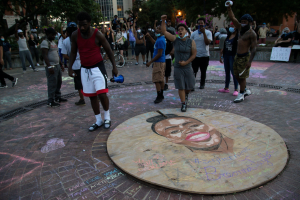Comeback since start of pandemic is kind to those who can work from home, to firms serving them and to regions hospitable to them. Many others are left behind.
A two-track recovery is emerging from the country’s pandemic-driven economic contraction. Some workers, companies and regions show signs of coming out fine or even stronger. The rest are mired in a deep decline with an uncertain path ahead.
Just months ago, economists were predicting a V-shaped recovery—a rapid rebound from a steep fall—or a U-shaped path—a prolonged downturn before healing began.
What has developed is more like a K. On the upper arm of the K are well-educated and well-off people, businesses tied to the digital economy or supplying domestic necessities, and regions such as tech-forward Western cities. By and large, they are prospering.
On the bottom arm are lower-wage workers with fewer credentials, old-line businesses and regions tied to tourism and public gatherings. They can expect to bear years-long scars from the crisis.
The divergence helps explain the striking disconnect of a stock market and household wealth near record highs, while lines stretch at food banks and applications for jobless benefits continue to grow.

In the latest example, consumer spending rose 1% in August but overall personal income fell 2.7% from July, in part because the unemployed received less government aid, according to Commerce Department figures reported Thursday.
E mployers have added 11.4 million jobs since the start of May, and economists surveyed by The Wall Street Journal estimate gross domestic product rose at a 23.9% annual rate in the third quarter. That some workers, industries and regions are managing to power through the pandemic explains why growth is so strong.
Those gains still leave the country well short of where it started the year. The pandemic and lockdowns knocked out 22.2 million jobs in March and April and caused the economy to shrink at a 31.4% rate in the second quarter and a 5% pace in the first. The pandemic has effectively erased all the economic growth of 2018 and 2019.
Even with recent gains, more jobs have been lost—nearly 11 million—than were cut in the wake of the 2007-09 recession, when 8.7 million were eliminated.
The gyrating numbers are a shock to a U.S. economy that had been averaging a little better than 2% annual growth for a decade. Together, the gains and losses show the economy at large is still in a hole after months of the fastest employment and output spurt on record, and could take years to fully dig out.
Still, many Americans who are working from home—along with those who serve them, from delivery drivers to home-improvement contractors—feel secure in their jobs, see retirement accounts still growing and are able to spend.
Businesses that serve those groups with increasingly digitized products are finding opportunity. For mostly white-collar industries, including information, management and professional services, economic output is poised to return to 2019 levels by the end of the year, some economists estimate.
While a K-shaped recovery appears to be taking hold, the economy’s path could shift. The virus remains unpredictable, and cases, deaths and related restrictions could rise this fall and winter. The presidential election, uneven economic recoveries in Europe and Asia and a persistent wave of corporate layoffs and bankruptcies infuse uncertainty into the U.S. outlook.
So does the threat that the damage for those on the lower arm of the K spills over to the rest of the economy in the form of reduced consumer spending and increased evictions and debt defaults.
Many lesser-skilled workers increasingly are finding that temporary furloughs have become permanent. Besides personal fallout from the cuts, economists worry about broader consumer demand.
“A lot of businesses weren’t affected or have returned to near-normal operations, but unemployment and underemployment remain extraordinarily high, and a lot of folks have nowhere near the income they had before the pandemic,” said Carl Tannenbaum, chief economist at financial-services company Northern Trust. “That’s going to ripple throughout the economy.”
Workers
Just before the pandemic, workers with historic disadvantages—including high-school dropouts, those with disabilities and Black and Hispanic workers—had seen their unemployment rates fall to the lowest on record as their pay rose. Women became the majority of workers on payrolls. The crisis hurt these groups disproportionately.
B lack and Hispanic women held many of the restaurant, retail and hospitality jobs that were badly hit by lockdowns. Black women held 11.9% fewer jobs in September than in February, and Hispanic women held 12.9% fewer, according to the Labor Department. White men have been the group least affected, with 5.4% fewer jobs.
“Women of color are more likely to be breadwinners for their household” than white women, said Rebecca Dixon, executive director of the National Employment Law Project, which advocates for low-wage workers. “And it’s particularly devastating when the family’s breadwinner loses their job.”
By September, workers with bachelor’s degrees or higher had nearly fully recovered jobs lost in early spring. But those with just a high-school diploma held 11.7% fewer jobs in September than in February, according to Labor Department data, and high-school dropouts had 18.3% fewer. The two groups combined were down by 4.4 million jobs—amounting to around 40% of the employment that remains lost since the pandemic began—although they are only 27% of the labor force.
Some of the most secure jobs during the pandemic are those that can be done remotely. More than 60% of management, business and financial jobs can be done from home, according to the Labor Department.
Nearly 30% of white employees held jobs they could do from home in 2017 and 2018, according to the department, compared to 19.7% of Black workers and 16.2% of Hispanic workers did.
The same Labor Department report found that 61.5% of the upper quarter of earners could work from home, compared with 9.2% of the bottom quarter.
Employers are hiring, but the pace has eased since June. If that continues, it would take several years for the U.S. to fully recover the jobs lost during two months this spring.
In April, nearly 90% of people who had just lost a job expected to return to it within six months, but by September only about half of recent job-losers did, according to the Labor Department.
And the laid-off are receiving less federal income support than they did earlier in the pandemic. In addition to one-time $1,200 payments that many households received under the Cares Act, a federal stimulus bill in March added $600 a week to unemployment benefits paid by states. Those $600 payments ended in July.
In early August, President Trump issued an order letting states tap disaster-relief funds to pay $300 a week in enhanced aid for an additional six weeks. Debate continues on Capitol Hill about further aid.
Feeding America, an organization that runs 200 food banks, says 17 million more people lack consistent access to enough food compared to last year, a leap of nearly 50%.
By August, nearly 27% fewer people were employed in jobs paying less than $16 an hour, according to an analysis by Evercore ISI economist Ernie Tedeschi. Those included many jobs at restaurants, hotels and shopping malls.
B ut on the K-shaped recovery’s top arm, the U.S. had as many workers earning more than $28 an hour by August as before the pandemic—many working in white-collar sectors such as tech, finance and medicine.
The insurance, scientific research and investment industries, plus the category of information services that includes aspects of Facebook and Google’s operations, had by September recovered all the jobs lost since February, according to the Labor Department. Other enterprises adding jobs included home-improvement stores, couriers and e-commerce warehouses—businesses largely involved in selling to the people who never lost their jobs.
Better-off Americans have largely recouped financial losses from the start of the pandemic. The S&P 500 stock index recovered all of the year’s losses and touched a new high in early September, although it has eased since then.
After a dip earlier in the year, total U.S. household net worth rose to a record level the second quarter, according to the Federal Reserve. The top fifth of income earners own about 71% of wealth in America, according to the Fed.
Homeowners are on the upper arm of the K-shaped economic recovery. They’re seeing values rise. The median sales price of an existing home in August was 11.4% higher than in August 2019, according to the National Association of Realtors.
Those with homes can also take advantage of historically low interest rates to trim mortgage bills or tap home-equity loans. This spring, 76% of white households owned their homes, while 47% of Black households did, according to the Census Bureau.
Industries
In an effort to contain the virus in the spring, government and business leaders temporarily shut down huge swaths of the country. As the dust has settled, some industries have remained depressed, others were hit less hard or have seen substantial recovery and some have benefited.
At first, the pain was broadly spread. Business-to-business spending, a rough proxy for economic activity, was running nearly 14% below 2019 levels by May, according to data from Cortera, a firm that collects details on spending from millions of companies.
As with jobs, the divide in corporate recovery roughly tracked the lines of viral transmission: Companies that operate through face-to-face transactions were at highest risk, while those that could do business remotely were are more secure.
So, casinos and theaters saw business evaporate, the air-travel industry slashed spending by two-thirds, restaurants cut their spending by half and gas stations cut spending by a quarter as commuting fell. Manufacturing and railroads slowed sharply, as did oil and gas extraction.
The Palmer House Hilton hotel in Chicago now is facing a bank foreclosure. High-end New York restaurants Per Se and Eleven Madison Park remain closed. Exxon Mobil Corp. is expected to lose $1 billion this year. Department storesNeiman Marcus Group and J.C. Penney Co., which were already buffeted by internet shopping, sought bankruptcy-court protection in May.
Within the reshaped landscape, some companies have adapted faster than others. As foot traffic evaporated, Chipotle Mexican Grill Inc. saw online orders more than triple in the second quarter, rising to 61% of total sales from about a quarter. The chain added staff and said it would include drive-through “Chipotlanes” at most new restaurants.
Lululemon Athletica Inc., after closing stores in the spring, was able to capture purchases by Americans working from home and eager for more comfortable “athleisure” clothing. The seller of high-end yoga pants embraced the shift to at-home fitness by buying Mirror, a start up that sells Internet-connected equipment and class subscriptions.
Other companies found the virus stoked demand for their wares. Spending by data hosting and processing companies rose 7% in April, from a year earlier, and slightly in May, as consumption of cloud services soared. Supermarket business thrived as families ate at home more and stockpiled staples. Electronics retailers saw business rise as people worked from home and went out for entertainment less.
Home-improvement chains like Home Depot Inc. and Lowe’s Cos. saw business soar as home-bound Americans went to work on their lawns and spare rooms and the housing market boomed. Walmart Inc. and rival Target Corp. recorded year-over-year sales jumps as Americans stocked up on essentials and turned to their e-commerce offerings. Amazon.com Inc. said last month that it would hire 100,000 more employees across North America.
In sectors on the upper arm of the K-shaped recovery—such as health care, financial and information—economic output is likely to surpass 2019 levels by the end of this year, according to Oxford Economics, a consulting firm. Construction and utilities aren’t far behind, it says.
But some types of businesses are unlikely to recover before 2024, the firm says, citing textiles and apparel, electrical equipment and appliance manufacturing as well as the petroleum, mining and coal industries. It could take until early 2022 for U.S. manufacturing to return to late-2019 levels, and until the end of next year for retailing and transportation, the firm says.
Broadly, sales and profits are showing signs of recovery. Retail sales have grown for four months straight through August, but the pace of that growth has slowed significantly.
Analysts expect third-quarter profits for large publicly traded companies to come in about 22% below 2019 levels, compared with the second quarter’s 31% drop, according to Refinitiv, a data firm that compiles consensus profit forecasts.
Economic production, despite a sharp bounce-back in the third quarter, still resembles the depths of the 2008-2009 recession, at roughly 95% of where it stood going into the crisis, said Gregory Daco, Oxford Economics’ chief U.S. economist.
“Not many things are viable if they’re just at [95%] of the revenue they usually have,” he said, and if they are, “they’re usually viable with lower input costs—reduced workforces.”
That poses a risk for the economy in coming months, analysts say. Growth in demand could slow or even stall if many Americans lose federal aid and spend down their savings, and if better-off households slow the kind of spending the pandemic prompted. The risk is that companies pull back on their own recovery plans, hiring more slowly or even initiating new layoffs—the hallmarks of a more traditional contraction.
“The risk is that…people don’t buy a third screen or don’t buy another desk, or they don’t order food out,” Mr. Daco said. ”We may not have seen all the pain from this recession.”
Regions
The pandemic’s economic effects ripple unevenly across geography, too.
Travel bans and worries about air travel have devastated destinations from Hawaii and Las Vegas to New York and Los Angeles, pinning tourism-dependent economies firmly on the recovery K’s lower arm.
Employment in Hawaii is down more than 16% since February, the worst of any state, according to the Labor Department. Hawaii’s leisure and hospitality employment remains less than half what it was before the pandemic, said Carl Bonham, an economics professor and executive director of the University of Hawaii Economic Research Organization.
Rises in coronavirus cases delayed until Oct. 15 the end of mandatory quarantine periods for visitors to Hawaii. With or without quarantines, tourists need to feel comfortable about travelling to come. “The virus is in control here,” Mr. Bonham said.
Florida, also tourism-heavy but less restrictive of business, has seen less job loss and faster recovery than states such as Hawaii. Orlando’s theme parks were able to open this summer, while Disneyland in California remains closed by government order. Florida’s August unemployment rate was right in the middle of the states at 7.4%. California’s 11.4% was fifth highest.
Among other states that set relatively light restrictions on businesses, Alabama, Georgia and Texas had unemployment rates below 7% in August, when the national rate was 8.4%. It fell to 7.9% in September.
Covid-19’s early surge in Northeastern states such as New York and Massachusetts led their officials to impose stringent rules about business closures and capacity limits. The precautions and the broader impact of the virus on confidence deepened economic downturns in some of the states, but they are rebounding now at a faster rate, said Adam Kamins, director of economic research at Moody’s Analytics.
The Northeast is home to many of the industries recovering best, such as finance and technology. Cities such as New York and Boston are flush with affluent and educated people who have generally fared well working from home.
Their absence is felt in business districts around office towers. The workers at downtown coffee shops and food trucks face severe challenges. There’s economic divergence not just among regions but within them.
Take the intersection of 42nd Street and Avenue of the Americas in midtown Manhattan, where Bank of America Corp. offices sit diagonally across from Bryant Park, said Mitchell Moss, a professor at New York University’s Robert F. Wagner Graduate School of Public Service. “At 6:30 p.m., you used to have 100 guys delivering dinner to those working late,” he said.
“We have no visitors and few workers,” he added. “Until we get one or the other back, it’s going to be a ghost town.”
Covid-19 has also sped up a shift under way before the disease appeared: the emergence of America’s Mountain West region, states such as Utah, Colorado and Idaho.
These lower-cost alternatives for industries such as technology and finance are on the recovery K’s upper arm, attracting a growing pool of young professionals.
“A combination of low costs, a strong workforce and high quality of life was already facilitating such a move. And if the appeal of big cities is diminished, it could hasten the flight to already-fast-growing regions,” Mr. Kamins of Moody’s said.
Write to Eric Morath at eric.morath@wsj.com, Theo Francis at theo.francis@wsj.com and Justin Baer at justin.baer@wsj.com




